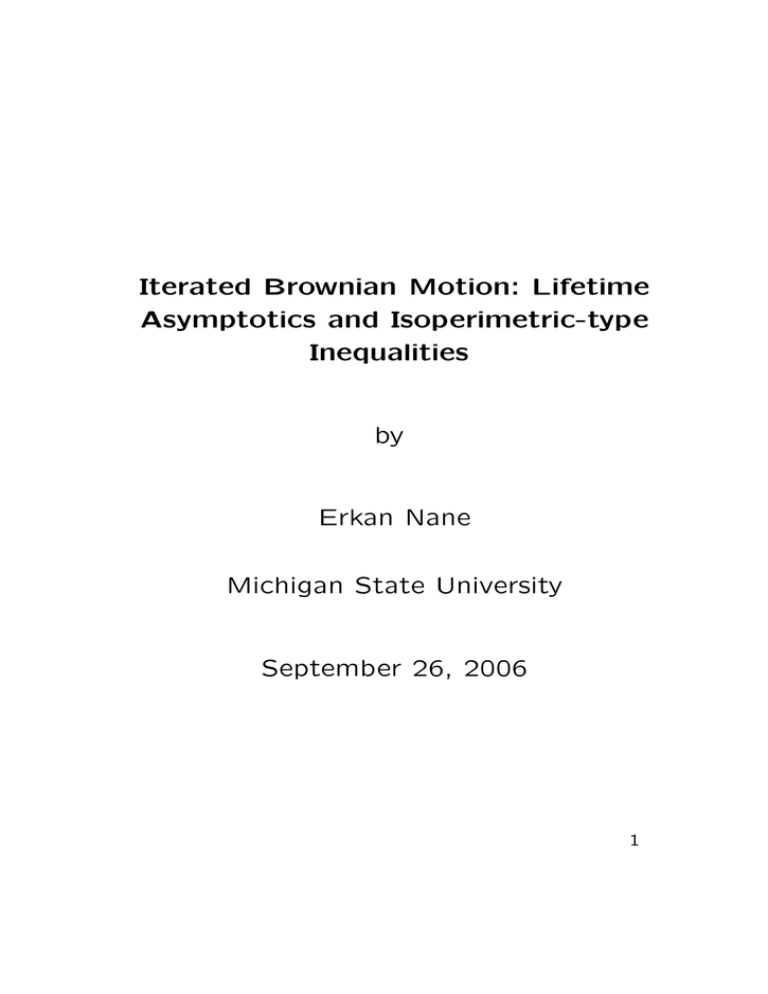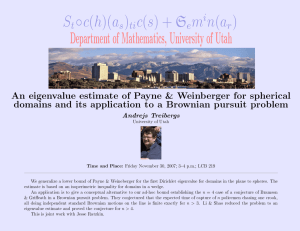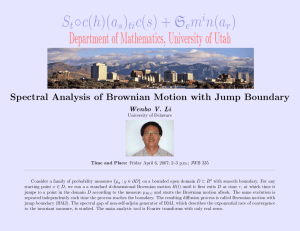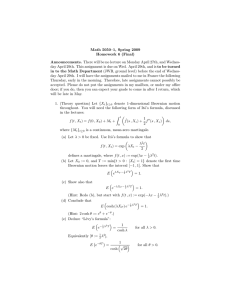Iterated Brownian Motion: Lifetime Asymptotics and Isoperimetric-type Inequalities by
advertisement

Iterated Brownian Motion: Lifetime
Asymptotics and Isoperimetric-type
Inequalities
by
Erkan Nane
Michigan State University
September 26, 2006
1
Outline
• Introduction and history
• Iterated processes in unbounded domains
• Iterated processes in bounded domains
• Isoperimetric-type inequalities
2
Introduction
To define iterated Brownian motion Zt, due
to Burdzy (1993), started at z ∈ IR, let Xt+, Xt−
and Yt be three independent one-dimensional
Brownian motions, all started at 0. Twosided Brownian motion is defined to be
X +,
t≥0
t
Xt =
X − , t < 0.
(−t)
Then iterated Brownian motion started at z ∈
IR is
Zt = z + X(Yt),
t ≥ 0.
3
BM versus IBM: This process has many
properties analogous to those of Brownian motion; we list a few
(1) Zt has stationary (but not independent)
increments, and is a self-similar process of
index 1/4.
(2) Laws of the iterated logarithm (LIL)
holds: usual LIL by Burdzy (1993)
Z(t)
25/4
lim sup 1/4
= 3/4
3/4
t→∞ t
(log log(1/t))
3
a.s.
Chung-type LIL by Khoshnevisan and Lewis
(1996) and Hu et al. (1995).
(3) Khoshnevisan and Lewis (1999) extended
results of Burdzy (1994), to develop a stochastic calculus for iterated Brownian motion.
4
(4) In 1998, Burdzy and Khosnevisan showed
that IBM can be used to model diffusion in a
crack.
(5) Local times of this process was studied by
Burdzy and Khosnevisan (1995), Csáki, Csörgö,
Földes, and Révész (1996), Shi and Yor (1997),
Xiao (1998), and Hu (1999).
(6) Bañuelos and DeBlassie (2006) studied the
distribution of exit place for iterated Brownian motion in cones.
5
PDE-connection:
In addition to the above properties there is an
interesting connection between iterated Brownian motion and the biharmonic operator ∆2;
the function
u(t, x) = Ex[f (Zt)]
solves the Cauchy problem (Allouba and Zheng
(2001) and DeBlassie (2004))
∂
u(t, x)
∂t
=
∆f (x)
1
√
+ ∆2u(t, x),
2
2πt
t > 0, x ∈ IRn
u(0, x) = f (x),
x ∈ IRn.
Let τD (Z) be the first exit time of iterated
Brownian motion from a domain D, started at
z ∈ D. Then Pz [τD (Z) > t] provides a measure of the lifetime of iterated Brownian
motion in D.
6
In light of the above PDE connection to biharmonic operator, there is hope the function
u(t, x) = Px[τD (Z) > t] solves
∂
1 2
u(t, x) =
∆ u(t, x), t > 0, x ∈ D,
∂t
2
u(0, x) = 1,
x ∈ D,
u(t, x) = 0,
x ∈ ∂D.
But, DeBlassie (2004) established that the function
u(t, x) = Px[τ(0,1)(Z) > t]
does not satisfy
∂4
∂
u(t, x) = a 4 u(t, x)
∂t
∂x
for any a > 0.
We follow another path to study the distribution of the exit time of iterated Brownian
motion in domains in IRn.
7
ITERATED PROCESSES IN UNBOUNDED
DOMAINS
Let D be a domain in IRn. Let
τD (Z) = inf{t ≥ 0 : Zt ∈
/ D}
be the first exit time of Zt from D. Write
±
τD
(z) = inf{t ≥ 0 :
Xt± + z ∈
/ D},
and if I ⊂ IR is an open interval, write
ηI = η(I) = inf{t ≥ 0 :
Yt ∈
/ I}.
8
By continuity of the paths of Zt = z + X(Yt)
±
(for f the pdf of τD
(z))
Pz [τD (Z) > t]
= Pz [Zs ∈ D for all s ≤ t]
= P [z + X +(0 ∨ Ys) ∈ D and
z + X −(0 ∨ (−Ys)) ∈ D for all s ≤ t]
+
−
= P [τD
(z) > 0 ∨ Ys and τD
(z) > 0 ∨ (−Ys)
for all s ≤ t]
+
−
= P [−τD
(z) < Ys < τD
(z)for all s ≤ t]
+
−
= P [η(−τD
(z), τD
(z)) > t],
=
Z ∞Z ∞
0
0
P0[η(−u,v) > t]f (u)f (v)dvdu.
Let τD be the first exit time of the Brownian
motion Xt from D. In the case of Brownian
motion in general cones, this has been done
by several people including Bañuelos and Smits
(1997), Burkholder (1977) and DeBlassie (1987):
for x ∈ D,
Px[τD > t] ∼ C(x)t−p(D), as t → ∞.
9
When D is a generalized cone, using the results
of Bañuelos and Smits, DeBlassie obtained;
Theorem. 1 (DeBlassie (2004)) For z ∈ D,
as t → ∞,
−p(D) ,
t
Pz [τD (Z) > t] ≈ t−1 ln t,
−(p(D)+1)/2
t
p(D) < 1
p(D) = 1
, p(D) > 1.
Here f ≈ g means that for some positive C1
and C2, C1 ≤ f /g ≤ C2.
For parabola-shaped domains the study of
exit time asymptotics for Brownian motion was
initiated by Bañuelos, DeBlassie and Smits.
Theorem. 2 (Bañuelos, et al. (2001)) Let
√
P = {(x, y) : x > 0, |y| < x}.
Then for z ∈ P,
log Pz [τP > t] ≈
1
3
−t
10
Subsequently, Lifshits and Shi found that the
above limit exists for parabola-shaped domains
Pα = {(x, Y ) ∈ IR × IRn−1 : x > 0, |Y | < Axα},
0 < α < 1 and A > 0 in any dimension;
Theorem. 3 (Lifshits and Shi (2002)) For z ∈
Pα,
1−α )
−( 1+α
lim t
t→∞
log Pz [τPα > t] = −l,
(1)
where
1 + α Γ2( 1−α
2α )
l=(
) L
1 )
α
Γ2( 2α
α
(α+1)
.
(2)
where
2/α
L=
π(n−3)/2
A22(3α+1)/α((1 − α)/α)(1−α)/α
.
Here (n−3)/2 denotes the smallest positive zero
of the Bessel function J(n−3)/2 and Γ is the
Gamma function.
11
By integration by parts Pz [τD (Z) > t] equals to
Z ∞Z ∞ ∂ ∂
0
0
P0[η(−u,v) > t]
∂u ∂v
.P [τD (z) > u]P [τD (z) > v]dvdu.
Theorem. 4 Let 0 < α < 1, A > 0 and let
Pα = {(x, Y ) ∈ IR× IRn−1 : x > 0, |Y | < Axα}.
Then for z ∈ Pα,
1−α )
−( 3+α
lim t
t→∞
log Pz [τPα (Z) > t] = −Cα,
where for l as in the limit given by (2)
1−α ) ( 2−2α ) ( 2+2α )
3 + α 1 + α ( 3+α
Cα = (
)(
)
π 3+α l 3+α .
2 + 2α 1 − α
In particular, for a planar iterated Brownian
motion in a parabola, the limit l = 3π 2/8 in
equation (2). Then from Theorem 4 for z ∈ P,
−1
7
lim t
t→∞
7π 2
log Pz [τP (Z) > t] = − 25/7 .
2
12
ITERATED PROCESSES IN BOUNDED
DOMAINS
For many bounded domains D ⊂ IRn the asymptotics of Pz [τD > t] is well-known. For
z ∈ D,
Z
λ
t
lim e D Pz [τD > t] = ψ(z)
ψ(y)dy,
(3)
t→∞
D
where λD is the first eigenvalue of 1
2 ∆ with
Dirichlet boundary conditions and ψ is its corresponding eigenfunction.
DeBlassie proved the following result for iterated Brownian motion in bounded domains;
Theorem. 5 (DeBlassie (2004)) For z ∈ D,
3 2/3 2/3
−1/3
lim t
log Pz [τD (Z) > t] = − π
λD .
t→∞
2
(4)
13
We have the following theorem which improves
the limit in (4).
Theorem. 6 Let D ⊂ IRn be a bounded domain for which (3) holds point-wise and let λD
and ψ be as above. Then for z ∈ D,
3 2/3 2/3 1/3
π
λD t
Pz [τD (Z) > t]
lim t−1/2 exp
t→∞
2
2
Z
λD 27/2
= √
ψ(z)
ψ(y)dy .
D
3π
14
Ingredients of the proof of Theorem 6 It
turns out that the integral over the set A is
the dominant one: K > 0 and M > 0 define A
as
A=
s
(u, v) :
K≤u≤
1 t
, u≤v≤
2 M
s
t
−u .
M
As t → ∞, uniformly for x ∈ (0, 1),
4 − π2t
Px[η(0,1) > t] ∼ e 2 sin πx.
π
We use Laplace transform method for integrals (de Bruijn (1958)). Let h and f be
continuous functions on IR. Suppose f is nonpositive and has a global max at x0, f 0(x0) = 0,
f 00(x0) < 0 and h(x0) 6= 0 and
Z ∞
0
h(x) exp(λf (x)) < ∞
for all λ > 0. Then as λ → ∞,
Z ∞
0
h(x) exp(λf (x))dx
s
∼ h(x0) exp(λf (x0))
2π
.
00
λ|f (x0)|
15
Pz [τD (Z) > t]
Z ∞Z ∞
t
]f (u)f (v)dvdu
P u [η(0,1) >
2
u+v
(u + v)
0
0
√
√
!
Z 1 t/M Z t/M −u
πu
2
≥ C1
sin
(u + v)
K
u
π 2t
. exp(−
) exp(−λD (u + v))dvdu,
2
2(u + v)
=
where C 1 = C 1(z) = 2(4/π)A(z)2(1−)3. Changing the variables x = u + v, z = u the integral
is
Z 1 √t/M Z √t/M
πz
π 2t
2
1
sin
exp(− 2 )
= C
x
2x
K
2z
. exp(−λD x)dxdz,
and reversing the order of integration
Z √t/M Z 1 x
2t
πz
π
2
exp(− 2 )
= C1
sin
x
2x
2K
K
. exp(−λD x)dzdx
Z √t/M
πK
π 2t
1
x cos
= C /π
exp(− 2 )
x
2x
2K
. exp(−λD x)dx
16
By Laplace transform method, after making
the change of variables x = (atb−1)1/3u, for
a = π 2/2, b = λD . As t → ∞,
πK
π 2t
x cos
exp(− 2 ) exp(−λD x)dx
x
2x
0
!
Z ∞
πK
=
(atb−1)1/3u cos
0
(atb−1)1/3u
1
. exp −a1/3b2/3t1/3( 2 + u) (atb−1)1/3du
u
r
π π 2 1/2 −1 1/2
3
2/3
∼ 2
( )
λD t
exp(− π 2/3λD t1/3).
3 2
2
Above x0 in the Laplace Transform method is
21/3.
Z ∞
17
ISOPERIMETRIC-TYPE INEQUALITIES
Let D ⊂ IRn be a domain of finite volume,
and denote by D∗ the ball in IRn centered at the
origin with same volume as D. The class of
quantities related to the Dirichlet Laplacian in D which are maximized or minimized by the corresponding quantities for
D∗ are often called generalized isoperimetrictype inequalities (C. Bandle (1980)).
Probabilistically generalized isoperimetric-type
inequalities read as
Pz [τD > t] ≤ P0[τD∗ > t]
(5)
for all z ∈ D and all t > 0, where τD is the first
exit time of Brownian motion from the domain
D and Pz is the associated probability measure
when this process starts at z.
Theorem. 7 Let D ⊂ IRn be an open set of
finite volume. Then
Pz [τD (Z) > t] ≤ P0[τD∗ (Z) > t]
(6)
for all z ∈ D and all t > 0.
18
Proof of Theorem 7
The idea of the proof is to use integration
by parts and the corresponding generalized
isoperimetric-type inequalities for Brownian motion. Let f ∗ denote the probability
density of τD∗ .
∂
P0[η(−u,v) > t] .
Gx(u, v, t) =
∂x
By integration by parts Pz [τD (Z) > t] equals
Z ∞Z ∞
=
≤
=
=
≤
Z0∞Z0∞
Z0∞Z0∞
Z0∞Z0∞
Z0∞Z0∞
Z0∞Z0∞
P0[η(−u,v) > t]f (u)f (v)dvdu.
Gv (u, v, t)P [τD (z) > v]f (u)dvdu
Gv (u, v, t)P [τD∗ (0) > v]f (u)dvdu
P0[η(−u,v) > t]f (u)f ∗(v)dvdu
Gu(u, v, t)P [τD (z) > u]f ∗(v)dudv
Gu(u, v, t)P [τD∗ (0) > u]f ∗(v)dudv
0
0
= P0[τD∗ (Z) > t]
19








